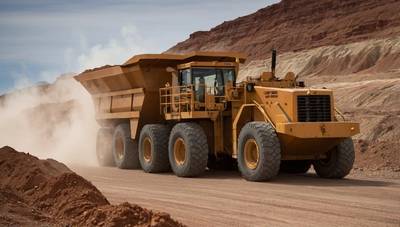Can Trump's drive for critical minerals pass the test of copper? Andy Home
The executive order issued by U.S. president Donald Trump on increasing domestic mineral production is designed to cut through the mine permit maze in the United States.
According to S&P Global, it takes on average nearly 29 years to bring a new mine from discovery to production. This is the second longest lead time in the entire world, after Zambia.
The U.S. Government is uniquely qualified to address the problem of granting permits on federal land.
The Joe Biden administration had a difficult time reconciling its desire to produce more "green metals" for the energy shift with its environmental and socio-political credentials.
Trump is not averse to such criticism.
The Secretary of Interior is directed to "prioritize the mineral production activities on Federal land over other types".
There is the danger, however, that the pendulum of politics will swing too far in the opposite direction. The problem is that it takes many years to construct new mines and the U.S. does not have the processing capability to turn raw materials into metal.
Copper is an example.
STALLED COPER PROJECTS
The executive order of Donald Trump does not include copper on the list of critical minerals in the United States, but it does mention gold, uranium and potash, as well as, if determined by the National Energy Dominance Council, any other element, "such coal".
Copper is the most common metal that has been used to illustrate the difficulty of establishing new mines in the United States.
The federal permit stage has been holding up big copper projects like Resolution in Arizona and Pebble in Alaska, as well as Twin Metals in Minnesota for many years.
The change in political winds in Washington could be beneficial to all three.
The opposition of Native Americans and environmental groups will not disappear with the stroke a president's pen. It could even become more entrenched.
Rio Tinto and Resolution, who own a majority stake, have learned the hard way how mining without community consent can be problematic.
Both the Serbian government and the European Union have endorsed Jadar's giant lithium mine, but mass protests have halted progress.
A LONGER TIME LINE
Resolution has the potential of becoming the largest copper producer in North America. It could meet up to 25% the annual demand for copper in the United States.
Copper will be accompanied by other minerals such as indium, tellurium and bismuth.
Even if the permitting process is accelerated, it will take 10 years for the mine to be built, so the first copper concentrates won't be produced until the middle of next decade.
Resolution is located in Arizona. This state has a rich history of mining, and infrastructure.
Pebble and Twin Metals face additional challenges due to their physical distance and the potential impact they could have on salmon spawning areas and the Boundary Waters Wilderness.
The fact that such projects are permitted quickly does not mean they will be ready to produce copper anytime soon.
PROCESSING GAP
Rio's Resolution Mine could be integrated with the company's current Kennecott smelting, refining and processing operations in Utah.
Kennecott is one of only two primary copper smelters operating in the United States. Miami, in Arizona, is operated by Freeport McMoRan. Although there have been rumors, no confirmation has yet been made that Grupo Mexico will reopen its Hayden Smelter in Arizona.
In the absence of adequate processing capacity, the United States has already become a net exporter for copper concentrates. According to the U.S. Geological Survey, 320,000 tons of concentrates containing metal were exported overseas in 2013.
Mexico, China and Canada were the three major destinations. There is clearly enough North American smelting capability to absorb additional U.S. mining production, but Trump's threats of tariffs against the United States two neighbours have replaced the Biden administration policy of "friend shoring".
Every copper smelter in the world is competing against China's smelting capacity, which is enormous and is still increasing.
The smelter margins have been squeezed by historically low treatment fees for converting raw materials into metal.
It could be more difficult to build new mines than to have the capacity in place at home.
URBAN SOLUTION
There is a much easier and cheaper solution to reduce U.S. dependence on imports than focusing on mega-mine projects that make headlines.
The U.S. recycling capacity is increasing.
Aurubis AG, a German company, has invested $800m in a new smelter for the treatment of up to 180,000 tons of complex recyclables like circuit boards.
United States exports copper scrap in excess of a million tonnes per year. A large amount of this scrap is sent to China to be processed.
The U.S. import dependence on copper would be significantly reduced if all the lost metal was recycled at domestic facilities.
Recycling has the advantages of a resource that is already available, a lower capital investment compared to new mines and fewer production delays.
The rush by the Trump administration to abandon anything that has anything to do with Biden's "green agenda" risks overlooking a part of the domestic supply chain for copper which is already attracting investments and increasing capacity.
The mantra "mine baby mine" will reap more rewards than any new large conventional mine if you channel more federal funds towards "urban mining".
The opinions expressed are those of David Evans, editor at (Editing).
(source: Reuters)



